【转】Vue.js——60分钟组件快速入门(上篇)
文章作者:keepfool
文章出处:http://www.cnblogs.com/keepfool/
组件简介
组件系统是Vue.js其中一个重要的概念,它提供了一种抽象,让我们可以使用独立可复用的小组件来构建大型应用,任意类型的应用界面都可以抽象为一个组件树:

那么什么是组件呢?
组件可以扩展HTML元素,封装可重用的HTML代码,我们可以将组件看作自定义的HTML元素。
本文的Demo和源代码已放到GitHub,如果您觉得本篇内容不错,请点个赞,或在GitHub上加个星星!
(所有示例都放在GitHub Pages上了,请访问https://github.com/keepfool/vue-tutorials查看示例汇总)
由于组件的篇幅较大,我将会把组件的入门知识分为两篇来讲解,这样也便于各位看官们快速消化。
组件的创建和注册
基本步骤
Vue.js的组件的使用有3个步骤:创建组件构造器、注册组件和使用组件。
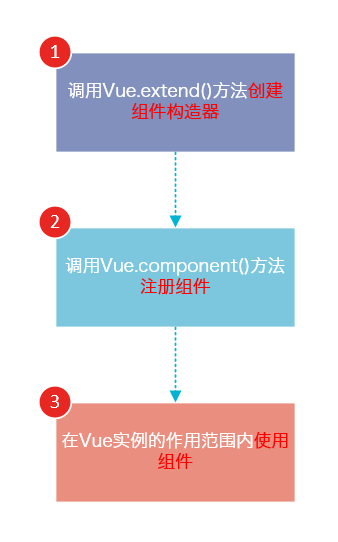
下面的代码演示了这3个步骤:
<!DOCTYPE html>
<html>
<body>
<div id="app">
<!-- 3. #app是Vue实例挂载的元素,应该在挂载元素范围内使用组件-->
<my-component></my-component>
</div>
</body>
<script src="js/vue.js"></script>
<script> // 1.创建一个组件构造器
var myComponent = Vue.extend({
template: '<div>This is my first component!</div>'
}) // 2.注册组件,并指定组件的标签,组件的HTML标签为<my-component>
Vue.component('my-component', myComponent) new Vue({
el: '#app'
}); </script>
</html>
运行结果如下:

可以看到,使用组件和使用普通的HTML元素没什么区别。
理解组件的创建和注册
我们用以下几个步骤来理解组件的创建和注册:
Vue.extend()是Vue构造器的扩展,调用Vue.extend()创建的是一个组件构造器。 2.
Vue.extend()构造器有一个选项对象,选项对象的template属性用于定义组件要渲染的HTML。 3. 使用
Vue.component()注册组件时,需要提供2个参数,第1个参数时组件的标签,第2个参数是组件构造器。 4. 组件应该挂载到某个Vue实例下,否则它不会生效。
请注意第4点,以下代码在3个地方使用了<my-component>标签,但只有#app1和#app2下的<my-component>标签才起到作用。
<!DOCTYPE html>
<html>
<body>
<div id="app1">
<my-component></my-component>
</div> <div id="app2">
<my-component></my-component>
</div> <!--该组件不会被渲染-->
<my-component></my-component>
</body>
<script src="js/vue.js"></script>
<script>
var myComponent = Vue.extend({
template: '<div>This is a component!</div>'
}) Vue.component('my-component', myComponent) var app1 = new Vue({
el: '#app1'
}); var app2 = new Vue({
el: '#app2'
})
</script>
</html>

全局注册和局部注册
调用Vue.component()注册组件时,组件的注册是全局的,这意味着该组件可以在任意Vue示例下使用。
如果不需要全局注册,或者是让组件使用在其它组件内,可以用选项对象的components属性实现局部注册。
上面的示例可以改为局部注册的方式:
<!DOCTYPE html>
<html>
<body>
<div id="app">
<!-- 3. my-component只能在#app下使用-->
<my-component></my-component>
</div>
</body>
<script src="js/vue.js"></script>
<script>
// 1.创建一个组件构造器
var myComponent = Vue.extend({
template: '<div>This is my first component!</div>'
}) new Vue({
el: '#app',
components: {
// 2. 将myComponent组件注册到Vue实例下
'my-component' : myComponent
}
});
</script>
</html>
由于my-component组件是注册在#app元素对应的Vue实例下的,所以它不能在其它Vue实例下使用。
<div id="app2">
<!-- 不能使用my-component组件,因为my-component是一个局部组件,它属于#app-->
<my-component></my-component>
</div> <script>
new Vue({
el: '#app2'
});
</script>
如果你这样做了,浏览器会提示一个错误:
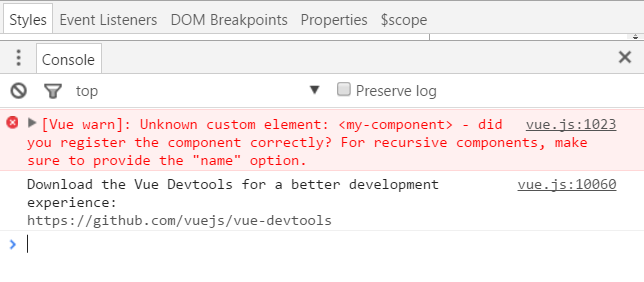
父组件和子组件
我们可以在组件中定义并使用其他组件,这就构成了父子组件的关系。
<!DOCTYPE html>
<html>
<body>
<div id="app">
<parent-component>
</parent-component>
</div>
</body>
<script src="js/vue.js"></script>
<script> var Child = Vue.extend({
template: '<p>This is a child component!</p>'
}) var Parent = Vue.extend({
// 在Parent组件内使用<child-component>标签
template :'<p>This is a Parent component</p><child-component></child-component>',
components: {
// 局部注册Child组件,该组件只能在Parent组件内使用
'child-component': Child
}
}) // 全局注册Parent组件
Vue.component('parent-component', Parent) new Vue({
el: '#app'
}) </script>
</html>
这段代码的运行结果如下:

我们分几个步骤来理解这段代码:
var Child = Vue.extend(...)定义一了个Child组件构造器var Parent = Vue.extend(...)定义一个Parent组件构造器components: { 'child-component': Child },将Child组件注册到Parent组件,并将Child组件的标签设置为child-component。template :'<p>This is a Parent component</p><child-component></child-component>',在Parent组件内以标签的形式使用Child组件。Vue.component('parent-component', Parent)全局注册Parent组件- 在页面中使用<parent-component>标签渲染Parent组件的内容,同时Child组件的内容也被渲染出来

Child组件是在Parent组件中注册的,它只能在Parent组件中使用,确切地说:子组件只能在父组件的template中使用。
请注意下面两种子组件的使用方式是错误的:
1. 以子标签的形式在父组件中使用
<div id="app">
<parent-component>
<child-component></child-component>
</parent-component>
</div>
为什么这种方式无效呢?因为当子组件注册到父组件时,Vue.js会编译好父组件的模板,模板的内容已经决定了父组件将要渲染的HTML。<parent-component>…</parent-component>相当于运行时,它的一些子标签只会被当作普通的HTML来执行,<child-component></child-component>不是标准的HTML标签,会被浏览器直接忽视掉。
2. 在父组件标签外使用子组件
<div id="app">
<parent-component>
</parent-component>
<child-component>
</child-component>
</div>
运行这段代码,浏览器会提示以下错误
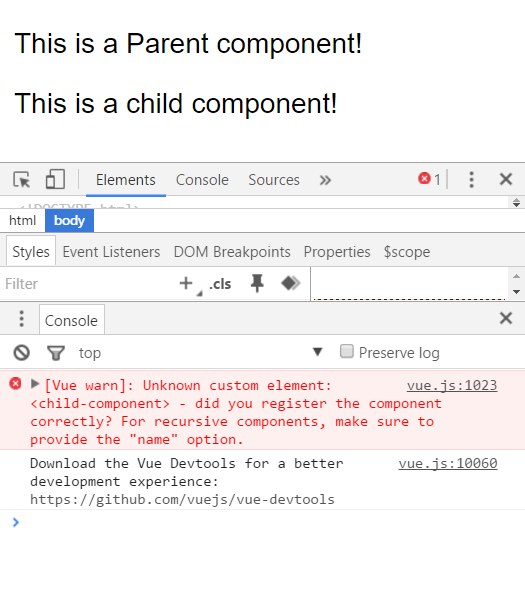
组件注册语法糖
以上组件注册的方式有些繁琐,Vue.js为了简化这个过程,提供了注册语法糖。
使用Vue.component()直接创建和注册组件:
// 全局注册,my-component1是标签名称
Vue.component('my-component1',{
template: '<div>This is the first component!</div>'
}) var vm1 = new Vue({
el: '#app1'
})
Vue.component()的第1个参数是标签名称,第2个参数是一个选项对象,使用选项对象的template属性定义组件模板。
使用这种方式,Vue在背后会自动地调用Vue.extend()。
在选项对象的components属性中实现局部注册:
var vm2 = new Vue({
el: '#app2',
components: {
// 局部注册,my-component2是标签名称
'my-component2': {
template: '<div>This is the second component!</div>'
},
// 局部注册,my-component3是标签名称
'my-component3': {
template: '<div>This is the third component!</div>'
}
}
})
使用script或template标签
尽管语法糖简化了组件注册,但在template选项中拼接HTML元素比较麻烦,这也导致了HTML和JavaScript的高耦合性。
庆幸的是,Vue.js提供了两种方式将定义在JavaScript中的HTML模板分离出来。
使用<script>标签
<!DOCTYPE html>
<html>
<body>
<div id="app">
<my-component></my-component>
</div> <script type="text/x-template" id="myComponent">
<div>This is a component!</div>
</script>
</body>
<script src="js/vue.js"></script>
<script> Vue.component('my-component',{
template: '#myComponent'
}) new Vue({
el: '#app'
}) </script>
</html>
template选项现在不再是HTML元素,而是一个id,Vue.js根据这个id查找对应的元素,然后将这个元素内的HTML作为模板进行编译。

注意:使用<script>标签时,type指定为text/x-template,意在告诉浏览器这不是一段js脚本,浏览器在解析HTML文档时会忽略<script>标签内定义的内容。

使用<template>标签
如果使用<template>标签,则不需要指定type属性。
<!DOCTYPE html>
<html>
<head>
<meta charset="UTF-8">
<title></title>
</head>
<body>
<div id="app">
<my-component></my-component>
</div> <template id="myComponent">
<div>This is a component!</div>
</template>
</body>
<script src="js/vue.js"></script>
<script> Vue.component('my-component',{
template: '#myComponent'
}) new Vue({
el: '#app'
}) </script>
</html>
在理解了组件的创建和注册过程后,我建议使用<script>或<template>标签来定义组件的HTML模板。
这使得HTML代码和JavaScript代码是分离的,便于阅读和维护。
另外,在Vue.js中,可创建.vue后缀的文件,在.vue文件中定义组件,这个内容我会在后面的文章介绍。
组件的el和data选项
传入Vue构造器的多数选项也可以用在 Vue.extend() 或Vue.component()中,不过有两个特例: data 和el。
Vue.js规定:在定义组件的选项时,data和el选项必须使用函数。
下面的代码在执行时,浏览器会提出一个错误
Vue.component('my-component', {
data: {
a: 1
}
})
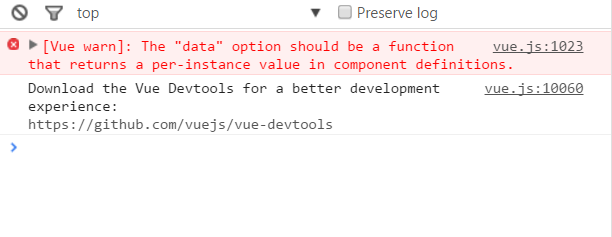
另外,如果data选项指向某个对象,这意味着所有的组件实例共用一个data。
我们应当使用一个函数作为 data 选项,让这个函数返回一个新对象:
Vue.component('my-component', {
data: function(){
return {a : 1}
}
})
使用props
组件实例的作用域是孤立的。这意味着不能并且不应该在子组件的模板内直接引用父组件的数据。可以使用 props 把数据传给子组件。
props基础示例
下面的代码定义了一个子组件my-component,在Vue实例中定义了data选项。
var vm = new Vue({
el: '#app',
data: {
name: 'keepfool',
age: 28
},
components: {
'my-component': {
template: '#myComponent',
props: ['myName', 'myAge']
}
}
})
为了便于理解,你可以将这个Vue实例看作my-component的父组件。
如果我们想使父组件的数据,则必须先在子组件中定义props属性,也就是props: ['myName', 'myAge']这行代码。
定义子组件的HTML模板:
<template id="myComponent">
<table>
<tr>
<th colspan="2">
子组件数据
</th>
</tr>
<tr>
<td>my name</td>
<td>{{ myName }}</td>
</tr>
<tr>
<td>my age</td>
<td>{{ myAge }}</td>
</tr>
</table>
</template>
将父组件数据通过已定义好的props属性传递给子组件:
<div id="app">
<my-component v-bind:my-name="name" v-bind:my-age="age"></my-component>
</div>
注意:在子组件中定义prop时,使用了camelCase命名法。由于HTML特性不区分大小写,camelCase的prop用于特性时,需要转为 kebab-case(短横线隔开)。例如,在prop中定义的myName,在用作特性时需要转换为my-name。
这段程序的运行结果如下:

父组件是如何将数据传给子组件的呢?相信看了下面这图,也许你就能很好地理解了。
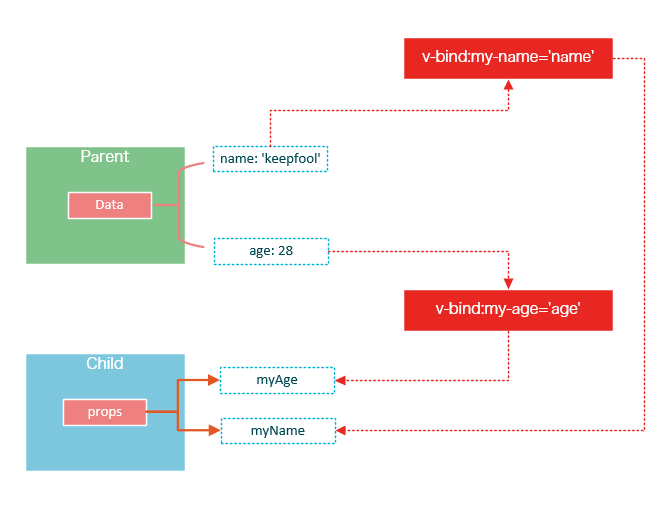
在父组件中使用子组件时,通过以下语法将数据传递给子组件:
<child-component v-bind:子组件prop="父组件数据属性"></child-component>
prop的绑定类型
单向绑定
既然父组件将数据传递给了子组件,那么如果子组件修改了数据,对父组件是否会有所影响呢?
我们将子组件模板和页面HTML稍作更改:
<div id="app"> <table>
<tr>
<th colspan="3">父组件数据</td>
</tr>
<tr>
<td>name</td>
<td>{{ name }}</td>
<td><input type="text" v-model="name" /></td>
</tr>
<tr>
<td>age</td>
<td>{{ age }}</td>
<td><input type="text" v-model="age" /></td>
</tr>
</table> <my-component v-bind:my-name="name" v-bind:my-age="age"></my-component>
</div> <template id="myComponent">
<table>
<tr>
<th colspan="3">子组件数据</td>
</tr>
<tr>
<td>my name</td>
<td>{{ myName }}</td>
<td><input type="text" v-model="myName" /></td>
</tr>
<tr>
<td>my age</td>
<td>{{ myAge }}</td>
<td><input type="text" v-model="myAge" /></td>
</tr>
</table>
</template>
运行这个页面,我们做两个小试验:
1. 在页面上修改子组件的数据

修改了子组件的数据,没有影响父组件的数据。
2. 在页面上修改父组件的数据
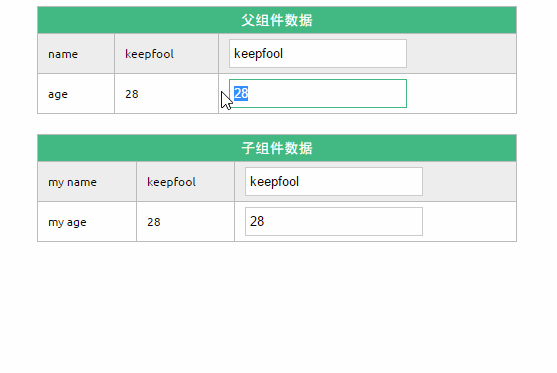
修改了父组件的数据,同时影响了子组件。
双向绑定
可以使用.sync显式地指定双向绑定,这使得子组件的数据修改会回传给父组件。
<my-component v-bind:my-name.sync="name" v-bind:my-age.sync="age"></my-component>
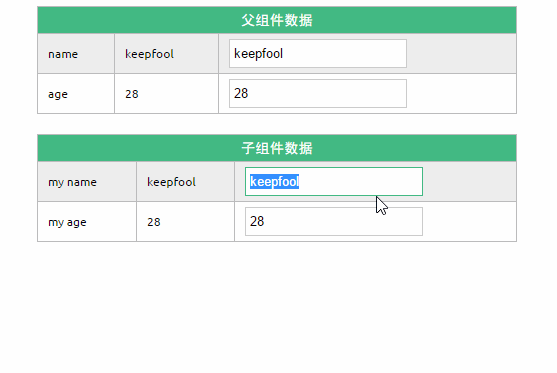
单次绑定
可以使用.once显式地指定单次绑定,单次绑定在建立之后不会同步之后的变化,这意味着即使父组件修改了数据,也不会传导给子组件。
<my-component v-bind:my-name.once="name" v-bind:my-age.once="age"></my-component>
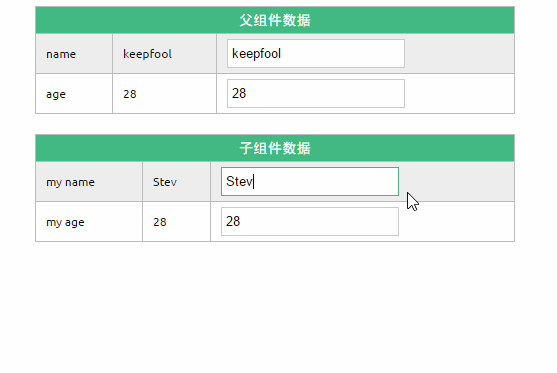
示例
为了尽快消化这些知识,我们来做一个小示例吧。
<!DOCTYPE html>
<html> <head>
<meta charset="UTF-8">
<title></title>
<link rel="stylesheet" href="styles/demo.css" />
</head> <body>
<div id="app">
<div id="searchBar">
Search <input type="text" v-model="searchQuery" />
</div>
<simple-grid :data="gridData" :columns="gridColumns" :filter-key="searchQuery">
</simple-grid>
</div> <template id="grid-template">
<table>
<thead>
<tr>
<th v-for="col in columns">
{{ col | capitalize}}
</th>
</tr>
</thead>
<tbody>
<tr v-for="entry in data | filterBy filterKey">
<td v-for="col in columns">
{{entry[col]}}
</td>
</tr>
</tbody>
</table>
</template> </body>
<script src="js/vue.js"></script>
<script>
Vue.component('simple-grid', {
template: '#grid-template',
props: {
data: Array,
columns: Array,
filterKey: String
}
}) var demo = new Vue({
el: '#app',
data: {
searchQuery: '',
gridColumns: ['name', 'age', 'sex'],
gridData: [{
name: 'Jack',
age: 30,
sex: 'Male'
}, {
name: 'Bill',
age: 26,
sex: 'Male'
}, {
name: 'Tracy',
age: 22,
sex: 'Female'
}, {
name: 'Chris',
age: 36,
sex: 'Male'
}]
}
})
</script> </html>
除了以上介绍的知识点,这个示例还用到了两个知识点:
1. prop验证
props: {
data: Array,
columns: Array,
filterKey: String
}
这段代码表示:父组件传递过来的data和columns必须是Array类型,filterKey必须是字符串类型。
更多prop验证的介绍,请参考:官方文档prop验证
2. filterBy过滤器
可以根据指定的字符串过滤数据。

总结
使用组件的前提是创建并注册组件,本篇文章详细介绍了组件从创建到使用的步骤,并介绍了几种不同的方式去创建和注册组件;然后介绍了组件的props选项,它用于将父组件的数据传递给子组件,最后我们用一个小的示例演示了这些知识点。
【转】Vue.js——60分钟组件快速入门(上篇)的更多相关文章
- 转: Vue.js——60分钟组件快速入门(上篇)
转自: http://www.cnblogs.com/keepfool/p/5625583.html Vue.js——60分钟组件快速入门(上篇) 组件简介 组件系统是Vue.js其中一个重要的概 ...
- Vue.js——60分钟组件快速入门(上篇)
组件简介 组件系统是Vue.js其中一个重要的概念,它提供了一种抽象,让我们可以使用独立可复用的小组件来构建大型应用,任意类型的应用界面都可以抽象为一个组件树: 那么什么是组件呢?组件可以扩展HTML ...
- Vue.js——60分钟组件快速入门
一.组件简介 组件系统是Vue.js其中一个重要的概念,它提供了一种抽象,让我们可以使用独立可复用的小组件来构建大型应用,任意类型的应用界面都可以抽象为一个组件树: 那么什么是组件呢?组件可以扩展HT ...
- Vue.js——60分钟组件快速入门(上篇)二
来源:https://www.cnblogs.com/keepfool/p/5625583.html 组件简介 组件系统是Vue.js其中一个重要的概念,它提供了一种抽象,让我们可以使用独立可复用的小 ...
- Vue.js——60分钟组件快速入门(下篇)
概述 上一篇我们重点介绍了组件的创建.注册和使用,熟练这几个步骤将有助于深入组件的开发.另外,在子组件中定义props,可以让父组件的数据传递下来,这就好比子组件告诉父组件:"嘿,老哥,我开 ...
- Vue.js——60分钟组件快速入门(下篇)
转自:https://www.cnblogs.com/keepfool/p/5637834.html 概述 上一篇我们重点介绍了组件的创建.注册和使用,熟练这几个步骤将有助于深入组件的开发.另外,在子 ...
- Vue.js 60 分钟快速入门
Vue.js 60 分钟快速入门 转载 作者:keepfool 链接:http://www.cnblogs.com/keepfool/p/5619070.html Vue.js介绍 Vue.js是当下 ...
- 不会几个框架,都不好意思说搞过前端: Vue.js - 60分钟快速入门
Vue.js——60分钟快速入门 Vue.js是当下很火的一个JavaScript MVVM库,它是以数据驱动和组件化的思想构建的.相比于Angular.js,Vue.js提供了更加简洁.更易于理 ...
- Vue.js——60分钟快速入门(转)
vue:Vue.js——60分钟快速入门 <!doctype html> <html lang="en"> <head> <meta ch ...
随机推荐
- A Survey of Visual Attention Mechanisms in Deep Learning
A Survey of Visual Attention Mechanisms in Deep Learning 2019-12-11 15:51:59 Source: Deep Learning o ...
- web页面引入字体
一.常见web字体 TrueType (.ttf) Windows和Mac系统最常用的字体格式,其最大的特点就是它是由一种数学模式来进行定义的基于轮廓技术的字体,这使得它们比基于矢量的字体更容易处理, ...
- 源码编译Redis Desktop Manager ---(转载)
精美文章转载: 版权声明:本文作者为「Kany.Wang」,本博客所有文章除特别声明外,均采用 CC BY-NC-SA 3.0 许可协议.转载请注明出处!原文链接:https://kany.me/20 ...
- kotlin基础 常见容器的取值范围
- 中国知网(cnki)上caj格式转pdf的方法 ----------------- 转载
原文地址: https://blog.csdn.net/edogawachia/article/details/85340636 版权声明:本文为博主原创文章,遵循 CC 4.0 BY-SA 版权协议 ...
- Python3基础 内置函数 eval str转为list tuple dict
Python : 3.7.3 OS : Ubuntu 18.04.2 LTS IDE : pycharm-community-2019.1.3 ...
- element-ui 上传图片 后清空 图片 显示
使用element-ui组件,用el-upload上传图片,上传图片后再次打开还是会有原来的图片,想要清空原来上传的图片,只需要在组件上绑定ref,在提交成功后的方法里调用this.$refs.upl ...
- pycharm安装、首次使用及汉化
摘自:https://blog.csdn.net/qq_30463497/article/details/84992480 一.下载pycharm安装包打开PyCharm的官方下载地址:http:// ...
- maven安装和应用
maven安装和应用 觉得有用的话,欢迎一起讨论相互学习~Follow Me 参考文献 https://www.cnblogs.com/xihehua/p/9639045.html https://w ...
- ODAC 安裝 (11.2.4)
1.下载解压 下载ODCA 安装包,下载地址:http://www.oracle.com/technetwork/database/windows/downloads/index-090165.htm ...
